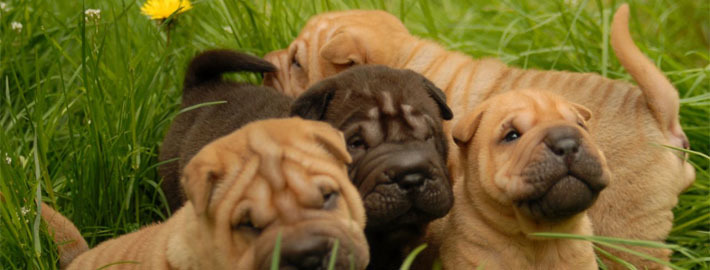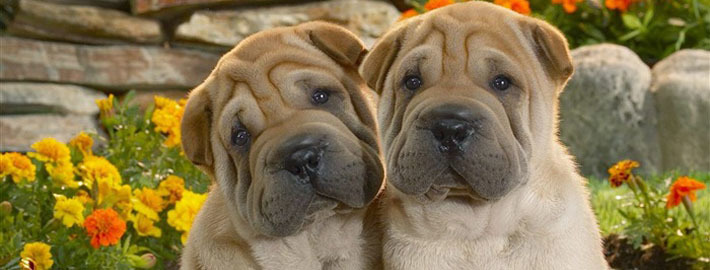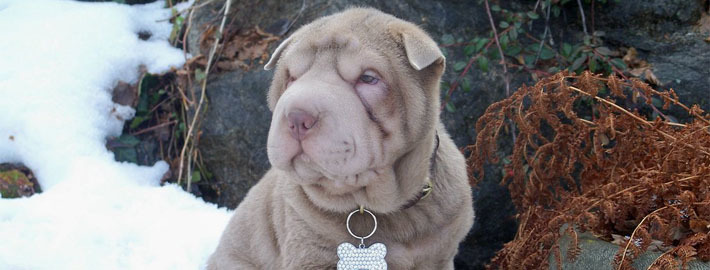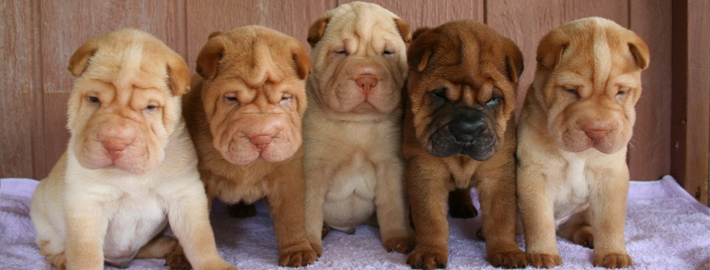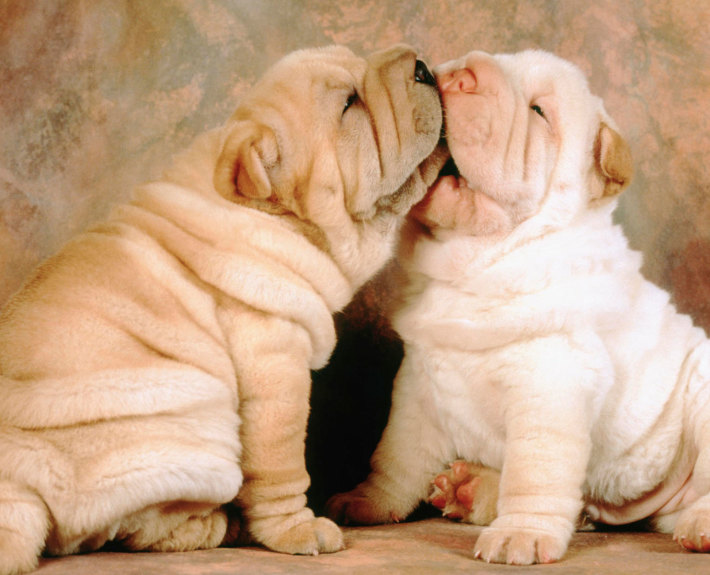What makes the Shar Pei Unique?
The Shar-Pei is compact and square, with a head slightly large for its body. Its signature wrinkles enabled it to twist away when grabbed by a dog when in a fight. Its stiff bristly coat further afforded protection against bites. The coat can be of either brush (not to exceed 1 inch) or horse (very short) types, both should be extremely harsh, straight and stand off the body. The small, close ears and small, sunken eyes afford further protection. The gait is free, with good reach and drive. The wide, powerful jaws, scowling expression and hippopotamus muzzle create a look unique to the breed.
Breed Groups
Page Contents
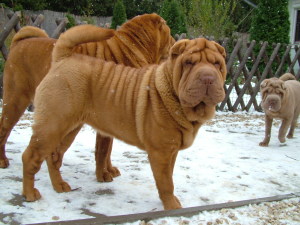
SnapShot
| Size: | Males – 18 to 22 in (46 to 56 cm) Females – 18 to 22 in (46 to 56 cm) |
| Weight: | Males – 55 to 65 lb (25 to 29 kg) Females – 40 to 55 lb (18 to 25 kg) |
| Origin: | China |
| Life Span: | 10 Years |
| Colour: | Red, Black, Sables, Cream, Blue, Brown, Cream Dilute, Chocolate, Chocolate dilute, Lilac |
| Litter Size: | 4 – 6 puppies |
Is the Shar Pei Right For You?
An intelligent and often stubborn breed, Shar Pei ownership needs careful consideration. They are bright and learn quickly, but early training and socialization are important, as is daily exercise. Shar-Pei are clean dogs that require little more grooming than an occasional bath, regular ear cleaning and toe nail clipping.
If you are considering purchasing a Chinese Shar-Pei puppy, learn more.
- Non-Sporting Group; AKC recognized in 1992.
- Ranging in size from 18 to 20 inches tall at the shoulder and 45 to 60 pounds.
- Hunting; guarding.
In 5 Words
- Devoted
- Reserved
- Suspicious
- Loving
- Independent
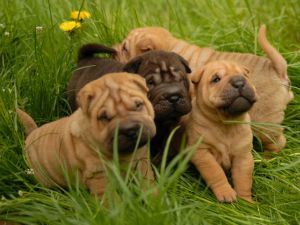
Characteristics
Learn About the Shar Pei
Description
General Description
The Chinese Shar-Pei is a large dog with wrinkled skin. It has a square profile with a broad, flat head. The muzzle is wide, padded and full, with a moderate stop. Like the Chow Chow, these dogs have a blue-black tongue. The teeth meet in a scissors bite. The small, sunken, almond-shaped eyes are dark, but may be lighter in dogs with a dilute colored coat. The high-set, triangular ears are very small and slightly rounded at the tips. The tail is thick at the base, tapering to a fine point and set extremely high. The dewclaws are sometimes removed. Both heavily wrinkled dogs with large heads and smaller-headed dogs with tighter-looking skin occur in this breed. Puppies have more wrinkles than adults. Shar-Pei slowly lose their wrinkles as they get older. There are three coat varieties: horse-coat, brush-coat and a rare bear-coat, which is not recognized by the AKC. The bear-coat does not fall within AKC standard because this particular Shar-Pei has an undercoat and a topcoat exceeding 1 inch. The popular theory about the bear-coat is that it’s a “throwback” to the Chow-Chow. They are actually quite popular as pet quality Shar-Pei, albeit rare, and often confused with the Chow by unknowing owners as well as animal shelter workers. The unusual horse-coat is rough to the touch, extremely prickly and off-standing. The brush-coated variety has longer hair and a smoother feel. The coat on all varieties can be up to one inch in length. Coat colors include all solid colors and sables. There is also a lowered, spotted and a parti colored (flowered) Shar-Pei coat, which is a disqualifying fault in the show ring according to AKC standard.
Short History of the Shar Pei
The Shar Pei breed comes from the Guangdong province of China. The original Shar-Pei from China looked very different from the breed now popular in the West. People in southern China, Hong Kong, and Macau differentiate the Western type and the original type by calling them respectively ‘meat-mouth’ and ‘bone-mouth’ Shar-Pei.
The ancestry of the Shar-Pei is uncertain. It may be a descendant of the Chow Chow; however, the only clear link between these is the blue-black tongue. However, pictures on pottery suggest the breed was present even in the Han Dynasty (206 BC). A statue on display at the Boston Museum of Fine Arts dating from the second century A.D. depicts a dog that strongly resembles a modern Shar Pei. For many years, the Shar-Pei was kept as a general-purpose farm dog in the Chinese countryside, used for hunting, protecting and herding stock and guarding the home and family. During that time, the Shar-Pei was bred for intelligence, strength and scowling face.
Matgo Law judging a Shar-Pei specialty show in Slovenia (2008)
DNA analysis conducted in the 2000s suggests that the Shar-Pei is one of a few oldest dog breeds, believed to have split from common ancestors earlier than other breeds. In 2004, the foundational analysis of purebred dog genetics was published in Science.[9] The resulting tree was profoundly asymmetrical. After wolves, just four groups sat its base: Asia’s shar-pei, along with shiba inu, akita and chow chow; central Africa’s basenji; malamutes from the Arctic, along with Siberian huskies and samoyeds; and from the Middle East, Afghan hounds and salukis.
The Shar Pei’s loose skin and extremely prickly coat were originally developed to help the dogs fend off wild boar, as they were used to hunt. Later, the breed was used for dog fighting; these enhanced traits made the Shar Pei difficult for its opponent to grab and hold on to, and so that if it did manage to hold on, the Shar Pei would still have room to maneuver and bite back; when grabbed by any loose wrinkle, a Shar Pei can actually twist in their skin and face in one’s direction. In fighting, they would twist in their skin to bite the assailant back.
Two Shar Pei
During the Communist Revolution, when the Shar Pei population dwindled dramatically, dogs were rescued by a Hong Kong businessman named Matgo Law, who in 1973 appealed to Americans through a dog magazine to save the breed. Around 200 Shar Peis were smuggled into America. The current American Shar Pei population stems mainly from these original 200.
Temperament
All Shar-Pei puppies need early socialization with children, strangers, and other animals. Like other fighting breeds, they can be stubborn, strong-willed and very territorial. Early training can help control these traits before they become problem behaviors. Some people may experience a sensitivity to the harshness of the coat of either length. This is a mild, short-lived rash that can develop on the skin that has been in contact with the coat, most commonly on the forearms.
The Shar Pei is often suspicious of strangers, which pertains to their origin as a guard dog. It is a very independent and reserved breed. Nevertheless, the Shar Pei is extremely devoted, loyal and affectionate to its family and is amenable to accepting strangers given time and proper introduction at a young age. If poorly socialized or trained, it can become especially territorial and aggressive. Even friendly and well-socialized individuals will retain the breed’s watch dog proclivities (like barking at strangers). It is a largely silent breed, barking only when it is playing or worried. The Shar-Pei were originally bred as palace guards in China. Although Shar-Pei are sometimes stubborn, they are receptive to fair, compassionate training. With repetition and a clear reward system, training is not very difficult, however they do not respond well to negative and cruel treatment. Overall, the Shar Pei can be a dog that is loyal and loving to its family while being very protective. Shar-Pei do not like to be alone, preferring to be close to their humans, often lying nearby in the same room.
Caring for Your Shar Pei
General Health
The breed is prone to fevers of uncertain causes, often afflicting the dog simultaneously with swollen hocks. Skin problems also bother the breed and are not commonly due to the wrinkles, but rather because of inheritable factors. In fact, the boom in shar pei breeding in the 1980’s may have helped aggravate most hereditary skin issues. Nevertheless, obtaining a puppy from a reputable breeder will help prevent this condition. Lastly, a common allergy in the breed is hay fever.
.
Grooming & Bathing
Chinese Shar-Peis are naturally clean animals who do not emit an order and only require minimal brushing once a week to remove dead hair from his minimally-shedding body. They don’t require frequent bathing; every 12 weeks is about the average. Over-bathing a Shar-Pei can cause skin ingratiation.
The most essential part of grooming a Shar-Pei is the maintenance of his wrinkles. After a bath, the wrinkles must be dried quickly and thoroughly to prevent yeast or fungal infections.
Exercise & Training
An active Shar Pei will not mind participating in any form of exercise, as long as they can have some off-leash time. Since this is the case, a well enclosed area/yard is ideal. His intelligence is not enough to keep him in line, which is why this breed needs consistent training and a confident handler. Anybody who seeks to bond with the dog must take care by not being too soft, too uncertain or too inconsistent, since the dog will want to take over if he thinks nobody is in charge. In fact, many of them are too stubborn to train!

